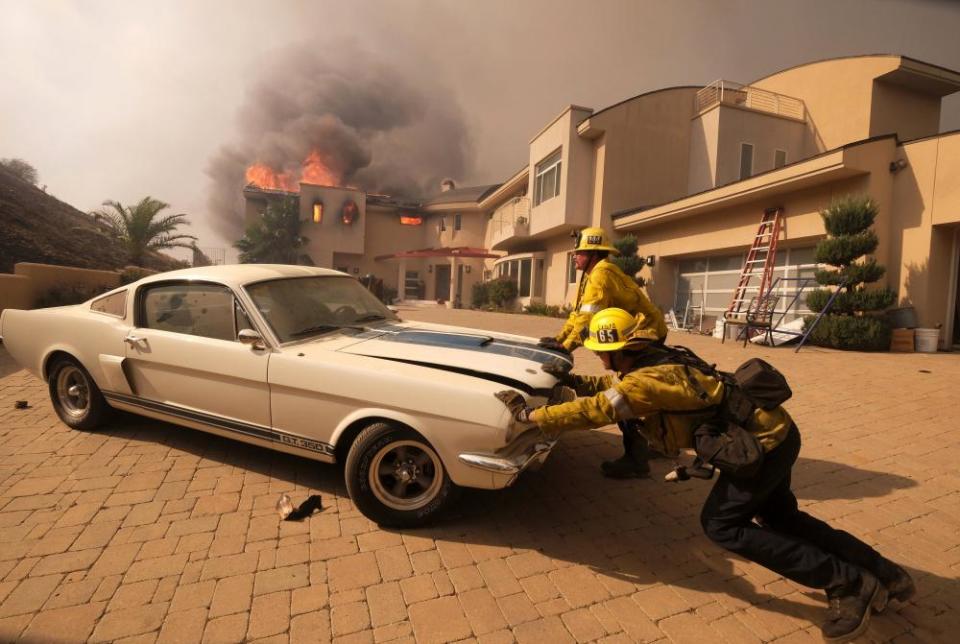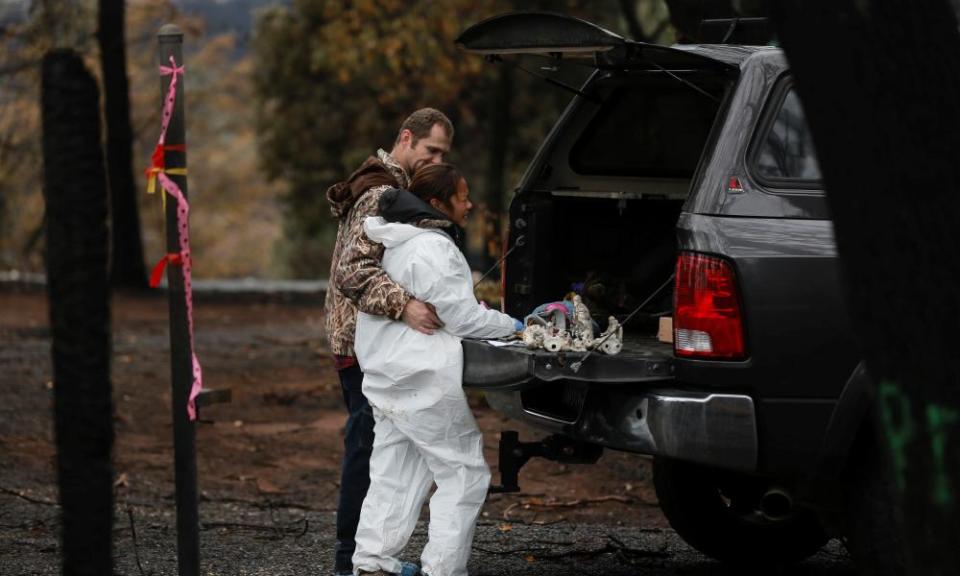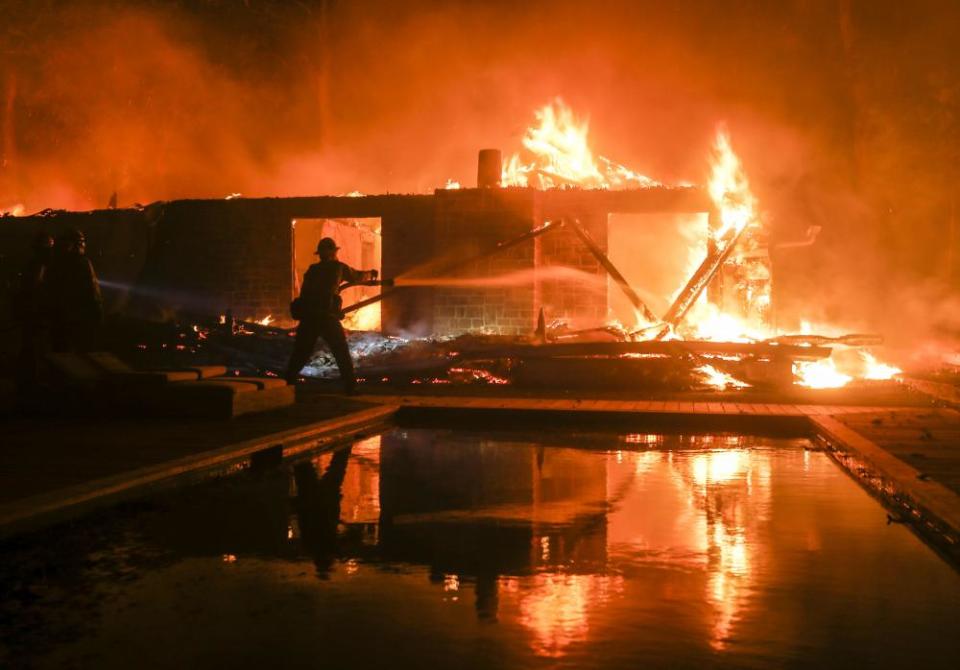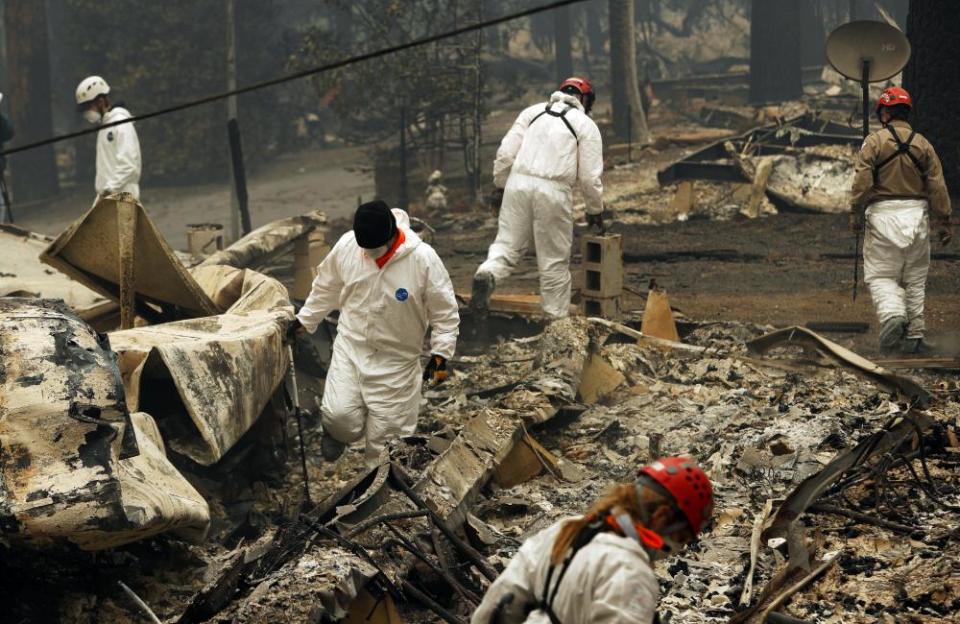A tale of two wildfires: devastation highlights California's stark divide
Some escaped Malibu by yacht while people fled Paradise on foot. But both cities face a brutal new normal, writes the scholar and urban theorist Mike Davis

California’s catastrophic wildfires – 25,000 homes destroyed over the last 18 months – have exposed and in some cases reinforced the socioeconomic inequalities that rend this state-nation of 40 million people.
If Malibu, where some residents were rescued by yacht, defines one side of the class fault line, Paradise, where many tried unsuccessfully to flee on foot, clearly represented the other. The median value of the homes destroyed in Malibu was $3,470,000; in Paradise, $200,000. One location is universally enviable; the other was affordable. Although both communities were relatively geriatric, with double the California average of over-65s, the Sierra Nevada foothill city of 27,000 also housed an extraordinary number of people with officially recognized disabilities, almost one-fifth of the under-65 population.
If their social worlds, Côte d’Azur v Appalachia, were leagues apart, they did share comparable environmental histories.
Malibu is the capital of the southern California “fire coast” that exists where communities have been built at the canyon mouths of densely vegetated coastal mountains. The steep-sided canyons, perfectly aligned with the direction of the annual dry hurricanes known in southern California as the Santa Anas and in the north as Diablos, act as bellows, accelerating the rush of fire to the beaches. Several wealthy beach towns around Los Angeles share this vulnerable situation with Malibu. Last December the city of Montecito, a sanctum of old wealth in Santa Barbara county, was overrun by the huge Thomas fire, punctually followed in January by mudslides that killed 23 people.

The Woolsey fire, which broke out on 8 November, is the 10th major conflagration in the hills above Malibu since an inferno in 1956 that was so intense it became a model for studying the likely effects of nuclear firestorms.
The recent fire started, mysteriously, in brush around the Santa Susana field laboratory, close to the city of Simi Valley, where white jurors sparked the 1992 LA riots by exonerating the police who beat Rodney King. The lab site was used by the federal government from 1953 to 1980 to test rockets and nuclear reactors. The disastrous core meltdown of a sodium reactor in 1959, the LA area’s own Chernobyl, was kept secret for years and now gives nightmares to residents who fear that the fire has spread carcinogenic soil contaminates in the atmosphere.
The Santa Anas, gusting to 70 miles per hour, pushed the fire westward, burning scores of homes, although the Calabasas mansion of Kim Kardashian and Kanye West was saved by a team of private firefighters – inaugurating what will inevitably become a new trend and status symbol for hill-dwelling celebrities. Then, easily vaulting over the eight lanes of the 101 freeway, the blaze reached the western Santa Monica Mountains, where it exploded in the dry chaparral and coastal sage.
The A-list of burned-out Malibu home owners includes Neil Young, Kim Basinger, Miley Cyrus, and Gerard Butler. In all, 1,500 homes were destroyed over a two-week period, testimony not only to the persistence of the conflagration but also to the amount of new construction since the last firestorm, in 1993.
Paradise, an old Gold Rush-era town (it was originally known as Poverty Gulch), sprawls along a partly forested and often wind-blasted ridge overlooking the Central Valley city of Chico. Over the last decade, it became an attractive refuge for retirees and disabled people on fixed incomes as well as building workers who couldn’t afford to live in the homes they constructed in the burgeoning suburbs on the valley floor.
Like Malibu, it has a fire history that reads like the arrest record of a master felon. Nine major fires have scourged the Paradise area in the last century, including two back-to-back blazes that reached the edge of town in the summer of 2008. The pyro-flora here includes Ponderosa and ghost pines, many of which are casualties of a drought-induced bark beetle infestation that has killed 128m California trees. Unlike residents of Malibu, where movie stars usually have a direct line to the governor, Paradise citizens possessed little political clout and subsisted on meager aid from a underfunded county government.

Although news reports leave the impression that both communities were blindsided by the incendiary outbreaks, they had in fact spent years preparing to face future firestorms.
In the case of Malibu, the 1993 fire that killed three residents and injured 565 firefighters led to new ordinances requiring brush clearance around homes and the use of fire-resistant building materials. Instead of a long-overdue debate about the wisdom of rebuilding in areas of extreme fire danger, residents and developers chased the mirage of “defensible space”. This slogan was echoed across California in the aftermath of other great fires, such as those that swept San Diego county in 2003 and 2007, burning 4,500 homes and killing 30 people. Even if fires were inevitable, the built environment could be made less vulnerable to combustion.
Paradise’s officials, for their part, could hardly order the cutting down of the forests that made the town attractive, so they focused on reducing the dangerous traffic jams and ensuing chaos that had made it impossible to safely empty the city during the encroaching June and July 2008 fires. With considerable grassroots participation, they devised a scheme for staggered evacuation that alerted neighborhoods to leave in order of their proximity to the fire front. They calculated from past experience that they would have four hours to move out people in an orderly fashion, including the many elderly and disabled residents.
In the event, Malibu proved no more fireproof than in 1993, even if a few homes constructed like concrete bunkers did survive, while Paradise, engulfed by flames moving twice as fast as predicted, became the first California city to be burned to its foundations since the great San Francisco inferno in 1906.

Surely this is a “teachable moment”, and one venerable California institution, the Los Angeles Times, under new ownership, broke taboos by suggesting that the state’s continuing fire emergency requires rational limitations on real estate construction in tinder-dry rural landscapes. Boldly it proposed that Paradise not be rebuilt.
Malibu, however, was a bridge too far for the LA Times and escaped mention. Although the upper quintile of the population may face temporary dislocation and more expensive insurance as a result of these disasters, it is working-class Californians in their desperate quest for affordable housing who will bear the greater cost of adjustment to the new fire regime associated with climate change. Indeed, wildfire often generates gentrification, as homes are rebuilt larger than before while trailer parks, rental units and under-insured housing are never restored. If the future is to be any different, then the Democratic super-majority that now rules in Sacramento needs to act decisively to rehouse “fire bowl” refugees from Paradise and other recent fires.
This is unlikely, if not impossible, without major federal assistance. But a vengeful presidential administration that blames the fires on “radical environmentalists” and threatens to cut aid because Californians don’t “rake their forests” like good Finns is unlikely to accommodate a rescue mission by House Democrats. On the other hand, the mega-developer-in-chief does robustly endorse environmental deregulation to sustain the residential land-rush into the fiery exurbs.
In San Diego county, where I live, 15,000 new homes, packaged as seven planned and mainly gated communities, are in the pipeline to be built in rural, high-fire-hazard areas. Although advertised as part of the solution to the housing crisis, these are almost entirely upper-end projects – 4,000-sq-ft homes and the like – well beyond the reach of average households. I confess, however, that I like to indulge my dark side by reading the fire plans and environmental impact reports that their developers, as required by law, are forced to make public.
One of my favorites – the plan for Otay Ranch Village 14, in a rugged site near the Mexican border – cooly observes: “The total of 68 fires in this area over the last 105 years within 5 miles of the Proposed Project is not considered a high number for southern California.” A fire every two years? Live with it.

